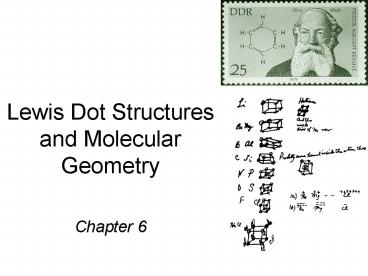Lewis Dot Structures and Molecular Geometry - PowerPoint PPT Presentation
1 / 35
Title:
Lewis Dot Structures and Molecular Geometry
Description:
Lewis Dot Structures and Molecular Geometry Chapter 6 Valence shell electron pair repulsion (VSEPR) model: Predicting Molecular Geometry Lewis Dot Structures and ... – PowerPoint PPT presentation
Number of Views:183
Avg rating:3.0/5.0
Title: Lewis Dot Structures and Molecular Geometry
1
Lewis Dot Structures and Molecular Geometry
- Chapter 6
2
Valence electrons are the outer shell electrons
of an atom. The valence electrons are the
electrons that particpate in chemical bonding.
9.1
3
9.1
4
The Ionic Bond
He
Ne
1s22s1
1s22s22p5
1s2
1s22s22p6
9.2
5
Chemistry In Action Sodium Chloride
Mining Salt
Solar Evaporation for Salt
6
A covalent bond is a chemical bond in which two
or more electrons are shared by two atoms.
Lewis structure of F2
9.4
7
Lewis structure of water
Double bond two atoms share two pairs of
electrons
or
Triple bond two atoms share three pairs of
electrons
or
9.4
8
Polar covalent bond or polar bond is a covalent
bond with greater electron density around one of
the two atoms
electron rich region
electron poor region
e- rich
e- poor
d
d-
9.5
9
Electronegativity is the ability of an atom to
attract toward itself the electrons in a chemical
bond.
Electron Affinity - measurable, Cl is highest
Electronegativity - relative, F is highest
9.5
10
9.5
11
9.5
12
Writing Lewis Structures
- Draw skeletal structure of compound showing what
atoms are bonded to each other. Put least
electronegative element in the center. - Count total number of valence e-. Add 1 for each
negative charge. Subtract 1 for each positive
charge. - Complete an octet for all atoms except hydrogen
- If structure contains too many electrons, form
double and triple bonds on central atom as needed.
9.6
13
Step 1 N is less electronegative than F, put N
in center
Step 2 Count valence electrons N - 5 (2s22p3)
and F - 7 (2s22p5)
5 (3 x 7) 26 valence electrons
Step 3 Draw single bonds between N and F atoms
and complete octets on N and F
atoms.
Step 4 - Check, are of e- in structure equal
to number of valence e- ?
3 single bonds (3x2) 10 lone pairs (10x2) 26
valence electrons
9.6
14
Step 1 C is less electronegative than O, put C
in center
Step 2 Count valence electrons C - 4 (2s22p2)
and O - 6 (2s22p4) -2 charge 2e-
4 (3 x 6) 2 24 valence electrons
Step 3 Draw single bonds between C and O atoms
and complete octet on C and O
atoms.
Step 4 - Check, are of e- in structure equal
to number of valence e- ?
3 single bonds (3x2) 10 lone pairs (10x2) 26
valence electrons
Step 5 - Too many electrons, form double bond
and re-check of e-
9.6
15
A resonance structure is one of two or more Lewis
structures for a single molecule that cannot be
represented accurately by only one Lewis
structure.
9.8
16
Exceptions to the Octet Rule
The Incomplete Octet
BeH2
BF3
9.9
17
Exceptions to the Octet Rule
Odd-Electron Molecules
NO
The Expanded Octet (central atom with principal
quantum number n gt 2)
SF6
9.9
18
Chemistry In Action Just Say NO
19
10.1
20
Valence shell electron pair repulsion (VSEPR)
model
Predict the geometry of the molecule from the
electrostatic repulsions between the electron
(bonding and nonbonding) pairs.
AB2
2
0
10.1
21
10.1
22
VSEPR
AB2
2
0
linear
linear
AB3
3
0
10.1
23
10.1
24
VSEPR
AB2
2
0
linear
linear
AB4
4
0
10.1
25
10.1
26
VSEPR
AB2
2
0
linear
linear
AB4
4
0
tetrahedral
tetrahedral
AB5
5
0
10.1
27
10.1
28
VSEPR
AB2
2
0
linear
linear
AB4
4
0
tetrahedral
tetrahedral
AB6
6
0
10.1
29
10.1
30
10.1
31
(No Transcript)
32
VSEPR
trigonal planar
trigonal planar
AB3
3
0
AB2E
2
1
10.1
33
VSEPR
AB4
4
0
tetrahedral
tetrahedral
AB3E
3
1
10.1
34
VSEPR
AB4
4
0
tetrahedral
tetrahedral
AB2E2
2
2
10.1
35
Predicting Molecular Geometry
- Draw Lewis structure for molecule.
- Count number of lone pairs on the central atom
and number of atoms bonded to the central atom. - Use VSEPR to predict the geometry of the molecule.
AB4E
AB2E
distorted tetrahedron
bent
10.1































